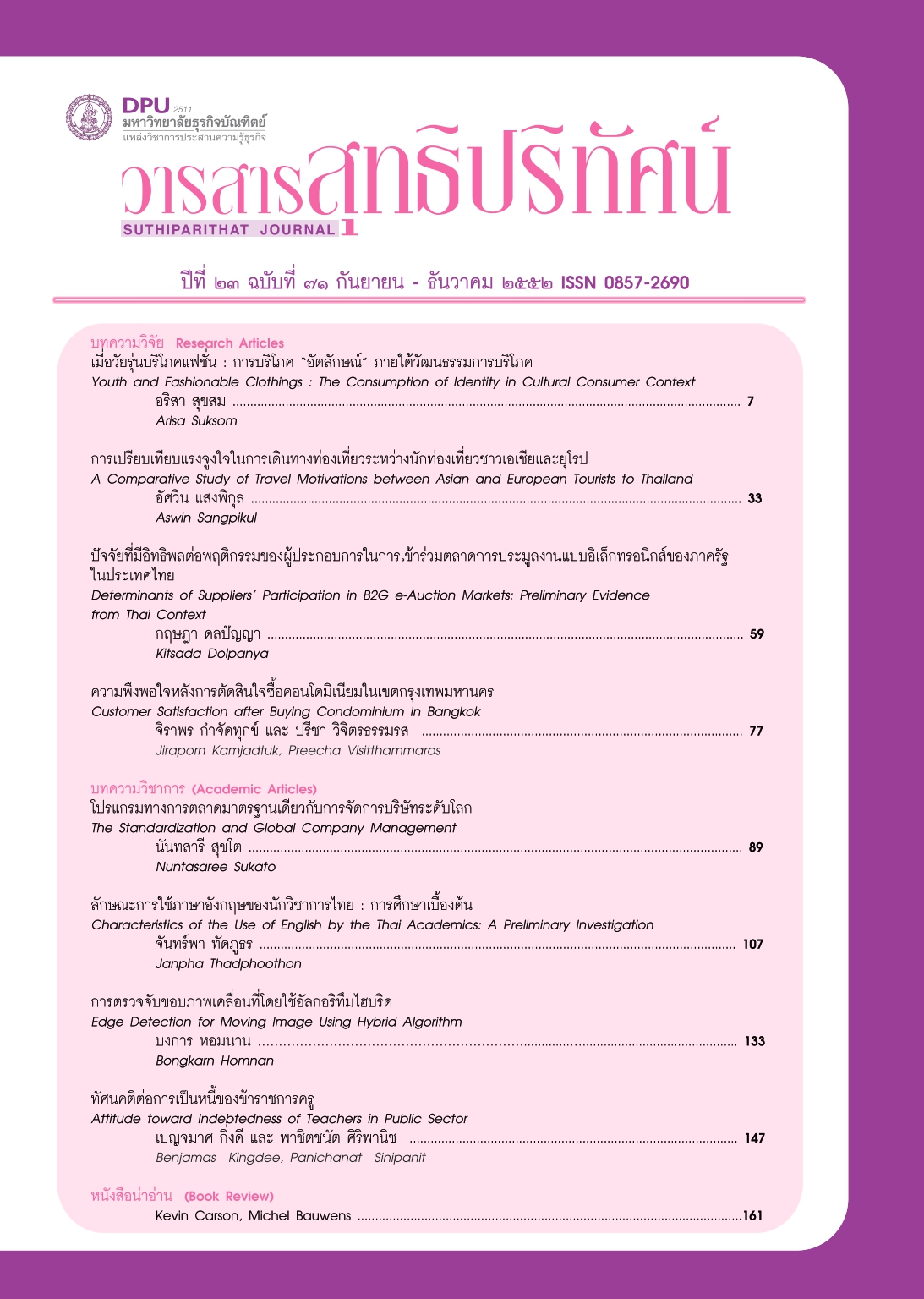โปรแกรมทางการตลาดมาตรฐานเดียวกับการจัดการบริษัทระดับโลก
คำสำคัญ:
การตลาดรูปแบบมาตรฐานเดียว, การตลาดรูปแบบประยุกต์, การตลาดระดับโลก, ยูโรดิสนีย์บทคัดย่อ
ในปัจจุบันโลกการค้าได้ขับเคลื่อนเข้าสู่ยุคตลาดไร้พรมแดน บรรดาบริษัทข้ามชาติและบริษัทระดับโลกพยายามใช้กลยุทธ์ต่างๆ ในอันที่จะสร้างความได้เปรียบเชิงการแข่งขันเพื่อความอยู่รอดของบริษัท การใช้โปรแกรมทางการตลาดก็เป็นกลยุทธ์อย่างหนึ่งซึ่งบริษัทใช้เพื่อตอบสนองความต้องการของลูกค้าและผู้บริโภค ในอันที่จะทำให้บริษัทได้รับความสำเร็จอย่างยั่งยืน แนวคิดโปรแกรมทางการตลาด 3 ประการ ได้แก่ รูปแบบมาตรฐานเดียว รูปแบบประยุกต์ และสถานการณ์ที่อาจเป็นไปได้ ได้ถูกวิเคราะห์ในประเด็นต่างๆ ที่เกี่ยวข้อง ในบทความนี้ปัญหาหลักคือการใช้โปรแกรมทางการตลาดรูปแบบมาตรฐานเดียวนั้นเหมาะสมสำหรับบริษัทระดับโลกที่ไปดำเนินธุรกิจในต่างประเทศหรือไม่ กรณีตัวอย่าง “ยูโรดิสนีย์” แสดงให้เห็นว่า โปรแกรมทางการตลาดรูปแบบมาตรฐานเดียวที่ครั้งหนึ่ง วอลต์ดิสนีย์ จากสหรัฐอเมริกาเคยใช้จนประสบผลสำเร็จอย่างงดงามในประเทศญี่ปุ่น อาจไม่ใช่คำตอบสำหรับทุกตลาด แต่แนวคิดสถานการณ์ที่อาจเป็นไปได้ น่าจะเป็นอีกทางเลือกหนึ่งสำหรับความสำเร็จของบริษัทระดับโลกได้เช่นกัน
เอกสารอ้างอิง
Ahluwalia, P. M. S. (2001) Case Study – Euro Disney: Its Limited Success. IN The Discussion Forum Sikhnet, India, Sikhnet. Retrived August 26, 2009 from http://www.Silkhnet.com
Andrus, D.M. & Norvell, D.W. (1990) The Effect of Foreign Involvement on the Standardization of International Marketing Strategies: an Empirical Study. International Journal of Management, December(7), 422-431.
Buzzell, R. D. (1968) Can You Standardize Multinational Marketing?. Columbia Journal of World Business, 4(March-April), 69-75.
Cateora, P.R. (1993) International Marketing, Boston, MA, Irwin.
Cavusgil, S.T. & Zou, S. (1994) Marketing Strategy-Performance Relationship: an Investigation of the Empirical Link in Export Market Venture. Journal of Marketing, 58(1), 1-21.
Cavusgil, S., Zou, S. & Naidu, G. (1993) Product and Promotion Adaptation in Export Ventures: an Empirical Investigation. Journal of International Business Studies, 24(3), 479-506.
Douglas, S. P. & Wind, Y. (1987) The Myth of Globalization. Columbia Journal of World Business, 22(4), 19-30.
Green, R. T. & Langeard, E. (1975) A Cross-National Comparison of Consumer Habits and Innovator Characteristics. Journal of Marketing, 39(July), 34-41.
Grosse, R. & Kujawa, D. (1992) International Business: Theory and Managerial Applications. Boston, MA, Irwin.
Hamel, G. & Prahalad, C. (1985) Do You Really Have a Global Strategy?. Harvard Business Review, 63(July-August), 139-148.
Hamilton, R.D. & Kashlak, R.J. (1999) National Influences on Multinational Corporation Control System Selection. Management International Review, 39(2), 167-189.
Huang, C.-W. & Tai, A.-P. (2003) A Cross-cultural Comparison of Customer Value Perceptions for Products: Consumer Aspects in East Asia. Cross Cultural Management, 10(4), 43-57.
Jain, S. C. (1989) Standardization of International Marketing Strategies: Some Research Hypotheses. Journal of Marketing, 53(January), 70-79.
Keegan, W. J. (1969) Multinational Product Planning: Strategic Alternatives. Journal of Marketing, 33, 58-62.
Kotler, P. (2000) Marketing Management. 10th ed. New Jersey, Prentice-Hall Inc.
Kreutzer, R. (1988) Marketing Mix Standardization: an Integrated Approach to Global Marketing. European Journal of Marketing, 20(10), 19-30.
Lau, G. (2009) The Venture of Euro Disney. IN National Leadership Conference 2009, Anaheim, CA, PBL National Secretary.
Levitt, T. (1983) Globalization of Markets. Harvard Business Review, 61(3), 69-81. Medina, J. F. & Duffy, M. F. (1998) Standardization vs Globalization: a New Perspective of Brand Strategies. Journal of Product & Brand Management, 7(3), 223-243.
Miracle, G. E. (1968) International Advertising Principles and Strategies. MSU Business Topics, Autumn, 29-36.
Ohmae, K. (1985) Triad Power: The Coming Shape of Global Competition. New York, NY, The Free Press.
Packman, H. M. & Casmir, F. L. (1999) Learning from the Euro Disney Experience : a Case Study in International/Intercultural Communication. Gazette,6(2), 473-489.
Ryan, J. K. (1969) Is It too Soon to Put a Tiger in Every Tank?. Columbia Journal of World Business, 4(March-April), 69-75.
Samiee, S. & Roth, K. (1992) The Influence of Global Marketing Standardization on Performance. Journal of Marketing, 56(April), 1-17.
Sandler, D. M. & Shani, D. (1992) Brand Globally but Advertise Locally?: an Empirical Investigation. International Marketing Review, 9(4), 18-31.
Sheth, J. N. (1972) A Conceptual Model of Long Range Multinational Planning. Management International Review, 12(4-5), 3-10.
Sorenson, R. Z. & Wiechmann, U. E. (1975) How Multinationals View Marketing Standardization. Harvard Business Review, 53(May-June), 38.
Wind, Y. (1986) The Myth of Globalization. Journal of Consumer Marketing, 3 (Spring), pp. 23-26.
Zou, S., Andrus, D. M. & Norvell, D. W. (1997) Standardization of International Marketing Strategy by Firms from a Developing Country. International Marketing Review, 14(2), 107-123.
Zou, S. & Cavusgil, S.T. (1996) Global Strategy: a Review and an Integrated Conceptual Framework. European Journal of Marketing, 30(1), 52-69.
ดาวน์โหลด
เผยแพร่แล้ว
รูปแบบการอ้างอิง
ฉบับ
ประเภทบทความ
สัญญาอนุญาต
เนื้อหาและข้อมูลในบทความที่ลงตีพิมพ์ในวารสารสุทธิปริทัศน์ ถือเป็นข้อคิดเห็นและความรับผิดชอบของผู้เขียนบทความโดยตรงซึ่งกองบรรณาธิการวารสาร ไม่จำเป็นต้องเห็นด้วย หรือร่วมรับผิดชอบใด ๆ
บทความ ข้อมูล เนื้อหา รูปภาพ ฯลฯ ที่ได้รับการตีพิมพ์ในวารสารสุทธิปริทัศน์ ถือเป็นลิขสิทธิ์ของวารสารสุทธิปริทัศน์หากบุคคลหรือหน่วยงานใดต้องการนำทั้งหมดหรือส่วนหนึ่งส่วนใดไปเผยแพร่ต่อหรือเพื่อกระทำการใด ๆ จะต้องได้รับอนุญาตเป็นลายลักษณ์อักษรจากวารสารสุทธิปริทัศน์ก่อนเท่านั้น







